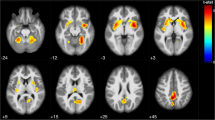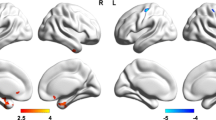Abstract
The paced auditory serial addition test (PASAT) is routinely used to evaluate the cognitive part of the multiple sclerosis functional composite (MSFC) score, the new reference index of patient disability. PASAT is sensitive to subtle cognitive impairment related to MS, although the cognitive components of this test still remain unclear. In order to better characterize brain systems involved during this complex task, functional magnetic resonance imaging (fMRI) experiments were conducted during PASAT in a population of ten normal subjects. The paradigm consisted of a series of 61 single-digit numbers delivered every 3 s. After each number, subjects were asked to overt vocalize the result of the addition of the two last numbers heard. A control task consisting of the repetition of the same series of single-digit numbers was used. Statistical group analysis was performed using the random effect procedure (SPM 99). Cortical activation was observed in the left prefontal cortex, the supplementary motor area, the lateral premotor cortex, the cingulate gyrus, the left parietal lobe, the left superior temporal gyrus, the left temporal pole, and visual associative areas. fMRI activations underlying PASAT were consistent with an involvement of verbal working memory and the semantic memory retrieval network which could be related to arithmetic fact retrieval. This study on normal subjects could provide a base for the understanding of the potential abnormal cortical activation in MS patients performing this test for a cognitive evaluation.
Similar content being viewed by others
References
Gronwall DM (1977) Paced auditory serial-addition task: a measure of recovery from concussion. Percept Mot Skills 44:367–373
Boringa JB, Lazeron RH, Reuling IE, Ader HJ et al. (2001) The brief repeatable battery of neuropsychological tests: normative values allow application in multiple sclerosis clinical practice. Mult Scler 7:263–267
Cutter GR, Baier ML, Rudick RA, Cookfair DL et al. (1999) Development of a multiple sclerosis functional composite as a clinical trial outcome measure. Brain 122:871–882
Fischer JS, Rudick RA, Cutter GR, Reingold SC (1999) The multiple sclerosis functional composite measure (MSFC): an integrated approach to MS clinical outcome assessment. National MS society clinical outcomes assessment task force. Mult Scler 5:244–250
Christodoulou C, DeLuca J, Ricker JH, Madigan NK et al. (2001) Functional magnetic resonance imaging of working memory impairment after traumatic brain injury. J Neurol Neurosurg Psychiatry 71:161–168
Staffen W, Mair A, Zauner H, Unterrainer J et al. (2002) Cognitive function and fMRI in patients with multiple sclerosis: evidence for compensatory cortical activation during an attention task. Brain 125:1275–1282
de Zubicaray GI, Wilson SJ, McMahon KL, Muthiah S (2001) The semantic interference effect in the picture-word paradigm: an event-related fMRI study employing overt responses. Hum Brain Mapp 14:218–227
Fos LA, Greve KW, South MB, Mathias C et al. (2000) Paced visual serial addition test: an alternative measure of information processing speed. Appl Neuropsychol 7:140–146
Oldfield RC (1971) The assessment and analysis of handedness: the Edinburgh inventory. Neuropsychologia 9:97–113
Friston KJ, Holmes AP, Price CJ, Buchel C et al. (1999) Multisubject fMRI studies and conjunction analyses. Neuroimage 10:385–396
Baddeley A (1992) Working memory. Science 255:556–559
Baddeley A (1986) Working memory. Oxford University, Oxford
Smith EE, Jonides J (1998) Neuroimaging analyses of human working memory. Proc Natl Acad Sci USA 95:12061–12068
Fiez JA, Raife EA, Balota DA, Schwarz JP et al (1996) A positron emission tomography study of the short-term maintenance of verbal information. J Neurosci 16:808–822
Salmon E, Van der Linden M, Collette F, Delfiore G et al. (1996) Regional brain activity during working memory tasks. Brain 119:1617–1625
Della Sala S, Logie RH, Marchetti C, Wynn V (1991) Case studies in working memory: a case for single cases? Cortex 27:169–191
Shallice T, Fletcher P, Frith CD, Grasby P et al. (1994) Brain regions associated with acquisition and retrieval of verbal episodic memory. Nature 368:633–635
Paulesu E, Frith CD, Frackowiak RS (1993) The neural correlates of the verbal component of working memory. Nature 362:342–345
Petrides M, Alivisatos B, Meyer E, Evans AC (1993) Functional activation of the human frontal cortex during the performance of verbal working memory tasks. Proc Natl Acad Sci USA 90:878–882
D’Esposito M, Detre JA, Alsop DC, Shin RK et al. (1995) The neural basis of the central executive system of working memory. Nature 378:279–281
D’Esposito M, Postle BR, Rypma B (2000) Prefrontal cortical contributions to working memory: evidence from event-related fMRI studies. Exp Brain Res 133:3–11
Petrides M (1994) Frontal lobes and behaviour. Curr Opin Neurobiol 4:207–211
Owen AM, Stern CE, Look RB, Tracey I et al. (1998) Functional organization of spatial and nonspatial working memory processing within the human lateral frontal cortex. Proc Natl Acad Sci USA 95:7721–7726
Chao LL, Knight RT (1998) Contribution of human prefrontal cortex to delay performance. J Cogn Neurosci 10:167–177
Christoff K, Prabhakaran V, Dorfman J, Zhao Z et al. (2001) Rostrolateral prefrontal cortex involvement in relational integration during reasoning. Neuroimage 14:1136–1149
Koechlin E, Basso G, Pietrini P, Panzer S et al. (1999) The role of the anterior prefrontal cortex in human cognition. Nature 399:148–151
Smith EE, Jonides J (1999) Storage and executive processes in the frontal lobes. Science 283:1657–1661
Bush G, Whalen PJ, Rosen BR, Jenike MA et al. (1998) The counting stroop: an interference task specialized for functional neuroimaging – validation study with functional MRI . Hum Brain Mapp 6:270–282
McCloskey M, Caramazza A, Basili A (1985) Cognitive mechanisms in number processing and calculation: evidence from dyscalculia. Brain Cogn 4:171–196
Dehaene S (1992) Varieties of numerical abilities. Cognition 44:1–42
Ashcraft MH (1992) Cognitive arithmetic: a review of data and theory. Cognition 44:75–106
Pesenti M, Seron X, van der Linden M (1994) Selective impairment as evidence for mental organisation of arithmetical facts: BB, a case of preserved subtraction? Cortex 30:661–671
Kroll NE, Markowitsch HJ, Knight RT, von Cramon DY (1997) Retrieval of old memories: the temporofrontal hypothesis. Brain 120:1377–1399
Markowitsch HJ (1995) Which brain regions are critically involved in the retrieval of old episodic memory? Brain Res Brain Res Rev 21:117–127
Gainotti G, Silveri MC, Daniele A, Giustolisi L (1995) Neuroanatomical correlates of category-specific semantic disorders: a critical survey. Memory 3:247–264
De Renzi E, Lucchelli F (1994) Are semantic systems separately represented in the brain? The case of living category impairment. Cortex 30:3–25
Grabowski TJ, Damasio H, Tranel D, Ponto LL et al. (2001) A role for left temporal pole in the retrieval of words for unique entities. Hum Brain Mapp 13:199–212
Noppeney U, Price CJ (2002) Retrieval of visual, auditory, and abstract semantics. Neuroimage 15:917–926
Damasio H, Grabowski TJ, Tranel D, Hichwa RD et al. (1996) A neural basis for lexical retrieval. Nature 380:499–505
Zago L, Pesenti M, Mellet E, Crivello F et al. (2001) Neural correlates of simple and complex mental calculation. Neuroimage 13:314–327
Dehaene S, Tzourio N, Frak V, Raynaud L et al. (1996) Cerebral activations during number multiplication and comparison: a PET study. Neuropsychologia 34:1097–1106
Rickard TC, Romero SG, Basso G, Wharton C et al. (2000) The calculating brain: an fMRI study. Neuropsychologia 38:325–335
Chochon F, Cohen L, van de Moortele PF, Dehaene S (1999) Differential contributions of the left and right inferior parietal lobules to number processing. J Cogn Neurosci 11:617–630
Dehaene S, Dehaene-Lambertz G, Cohen L (1998) Abstract representations of numbers in the animal and human brain. Trends Neurosci 21:355–361
Cowell SF, Egan GF, Code C, Harasty J et al. (2000) The functional neuroanatomy of simple calculation and number repetition: a parametric PET activation study. Neuroimage 12:565–573
Acknowledgments.
This work is funded by the CNRS (UMR 6612), the Institut Universitaire de France, the Association pour la Recherche contre la Sclérose en Plaques (ARSEP) and Biogen France.
Author information
Authors and Affiliations
Corresponding author
Additional information
This revised version was published in March 2005 with corrections to the history.
Rights and permissions
About this article
Cite this article
Audoin, B., Ibarrola, D., Duong, M. et al. Functional MRI study of PASAT in normal subjects. MAGMA 18, 96–102 (2005). https://doi.org/10.1007/s10334-004-0098-9
Received:
Revised:
Accepted:
Published:
Issue Date:
DOI: https://doi.org/10.1007/s10334-004-0098-9




